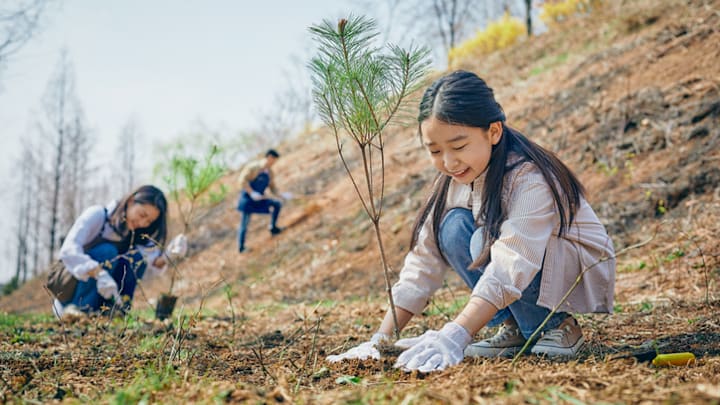Kermit got it all wrong: It is easy being green. Committing to going greener doesn’t have to mean a 10-mile walk to work or abiding by “if it’s yellow, let it mellow”—you can make a difference by making small adjustments that add up to big change. Here are 11 ideas to get you started for Earth Day.
1. Use your dishwasher to go green.

It may seem counterintuitive, but your dishwasher is way more energy- and water-efficient at washing dishes than you are, as long as you’re running a full dishwasher. According to one German study, dishwashers use half of the energy and a sixth of the water, not to mention less soap. So, don’t feel guilty about skipping the sink of sudsy water, or about not pre-rinsing before loading up the machine—you’re actually doing the environment a favor by firing up your dishwasher.
2. Switch to online bill paying and use less paper.

Not only is it convenient to pay all of your bills with a click or two, it’s also an easy way to go greener. One study found that the average U.S. household receives 19 bills and statements from credit card companies, banks, and utilities every month. By switching to online statements and online bill pay, each American household could save at least several pounds of paper and avoid producing over 170 pounds of greenhouse gases. Not bad for simply clicking a few “receive online statements” boxes.
3. Opt out of junk mail and catalogs.

While you’re paring down the amount of stuff that arrives daily in your mailbox, visit Catalog Choice to opt out of various mailers you don’t want to receive. The non-profit organizations recommends that you sign up for the USPS Do Not Mail service at the same time so you can hit multiple junk-mailers efficiently.
4. Plant a tree so Earth Day is every day.

Planting trees is obviously great for the environment, but if you’re strategic about it, it can help you reduce your energy costs and use less fossil fuel. According to ArborDay.org, planting large deciduous trees on the east, west, and northwest sides of your house can shade and cool your home during the warmer months, even slashing your air conditioning costs by up to 35 percent. To maximize your impact, choose tree species that are native to your part of the country—you’ll be cooling your home as well as providing food and habitat for pollinators, birds, and other wildlife.
5. Turn off the tap while you’re standing at the sink.

Leaving the tap running while you tend to your pearly whites each morning and night uses about eight gallons of water a day. Just turn the tap on when you need to wet your brush or rinse, instead of letting H20 pour uselessly down the drain. The same goes for anyone who shaves with the water running.
6. Go thrifting for clothes and housewares.

Hitting up some thrift shops is a green idea—and that goes for whether you’re getting rid of clutter or adding household essentials to your home. Buying and donating to thrift stores and second-hand shops means you’re recycling, supporting your local economy, and saving money.
7. Get a houseplant to clear the air.

And grab a little guy for your desk at work, too. House plants and desk plants have been proven to improve your mood and raise productivity, but they also purify the air by removing volatile organic compounds (VOCs) found in homes and offices. They also absorb carbon dioxide and increase the humidity. Low-maintenance plants include pothos, spider plants, jade, various succulents, and peace lilies.
8. Get scrappy with art and crafts.

Cut up paper that has only been used on one side and use it to scribble reminders, notes, grocery lists, and more. Or flip it over for any kids you know to color on. (You can color on it, too, if you want.)
9. Put your caffeine fix to work for our planet.

Your coffee likely traveled thousands of miles to arrive in your pantry, so get good use out of it. Use your grounds to mulch plants that love acidic soil, like roses, evergreens, and rhododendrons. If your garden problems tend to be less about the dirt and more about the things that live in it, certain garden pests hate coffee—namely ants, slugs, and snails. Sprinkle grounds in problem areas to deter them.
10. Enlighten yourself to energy savings.

Compact fluorescent bulbs (CFLs—the spiral light bulbs) may cost more upfront, but they’ll save up to $57 over the life of the bulb. More importantly, they use 70 percent less energy than traditional bulbs and installing them is as easy as screwing in a light bulb. (Sorry.)
11. Make tracks instead of short car trips.

You don’t have to cut out your daily driving entirely, but when you only have a few blocks, or perhaps just a mile or two to travel and don’t need to transport anything bulky, consider walking, rollerblading, or hopping on your bike. Giving up the car and and walking just one day a week could cut your personal carbon output by a quarter, according to a 2021 study.
A version of this story ran in 2019; it has been updated for 2023.
